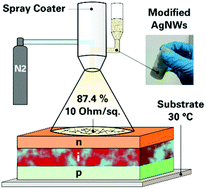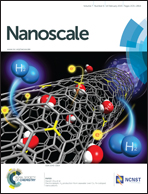A spray-coating process for highly conductive silver nanowire networks as the transparent top-electrode for small molecule organic photovoltaics†
Abstract
We present a novel top-electrode spray-coating process for the solution-based deposition of silver nanowires (AgNWs) onto vacuum-processed small molecule organic electronic solar cells. The process is compatible with organic light emitting diodes (OLEDs) and organic light emitting thin film transistors (OLETs) as well. By modifying commonly synthesized AgNWs with a perfluorinated methacrylate, we are able to disperse these wires in a highly fluorinated solvent. This solvent does not dissolve most organic materials, enabling a top spray-coating process for sensitive small molecule and polymer-based devices. The optimized preparation of the novel AgNW dispersion and spray-coating at only 30 °C leads to high performance electrodes directly after the deposition, exhibiting a sheet resistance of 10.0 Ω □−1 at 87.4% transparency (80.0% with substrate). By spraying our novel AgNW dispersion in air onto the vacuum-processed organic p-i-n type solar cells, we obtain working solar cells with a power conversion efficiency (PCE) of 1.23%, compared to the air exposed reference devices employing thermally evaporated thin metal layers as the top-electrode.


 Please wait while we load your content...
Please wait while we load your content...